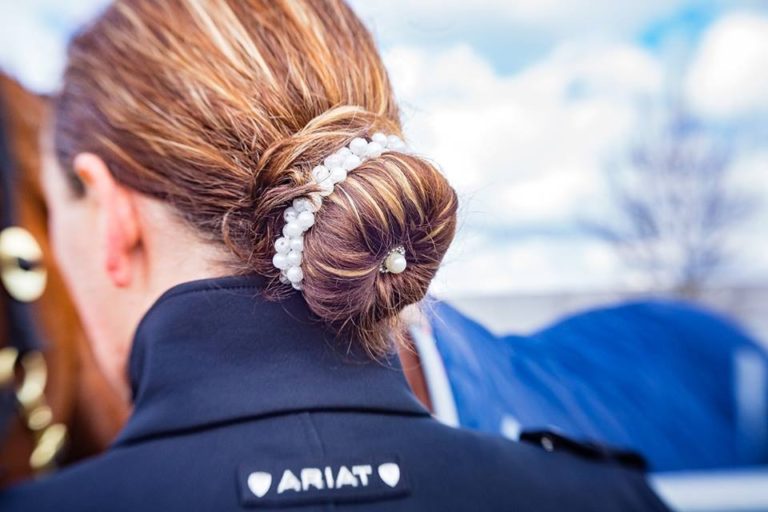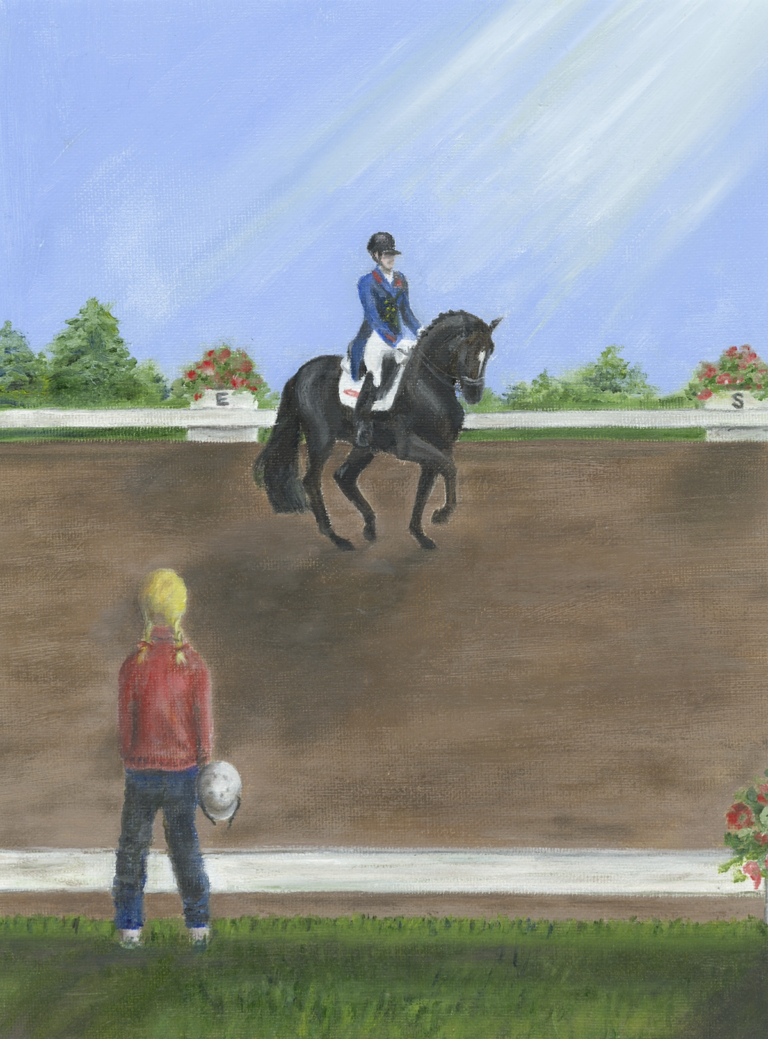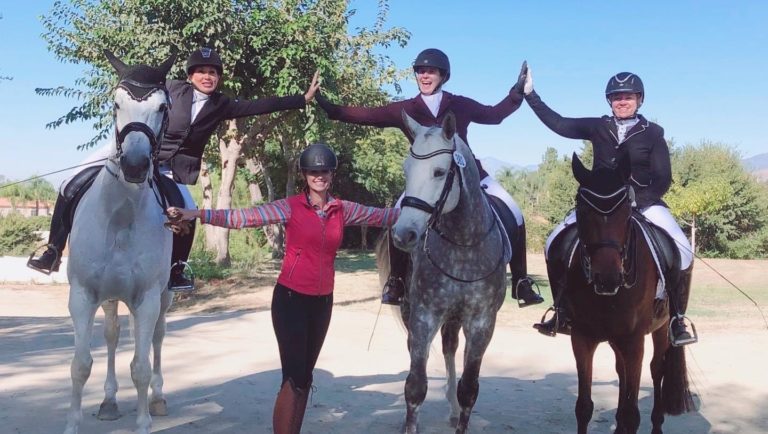For the past two months, we examined muscles at the front and the back of the torso. Now we’ll look at the sides to complete our work with the torso.
When you ride, you need good stability in your waist. If proper control of these muscles in your body is lacking, it is hard to provide a framework for your horse to mold himself around. Instead, he will be able to squirm out of position.
For example, if you do a circle and you do not have good control of your waist, your horse may push out with his outside shoulder and just bend his neck instead. Then you will be left with the inside of your waist contracted and your outside stretched too long with uneven weight in your two seat bones and a loss of security in your seat. Although the metaphorical wall—which includes your outside leg and rein—should stop him from pushing out, we sometimes forget about our core, which also should help keep him correctly aligned.
Your core is your main tool to press back against your horse when he tries to wriggle out of correct alignment. Part of your core includes the internal obliques, but other muscles that will help you control your waist are the external obliques and the quadratus lumborum. Working these muscles evenly over their range of movement will allow you to maintain better control over your horse’s body.
Evenness in the range and strength of both sides of your waist will also help you to counteract any unevenness in your hips and ribs. Collapsing your hips and ribs can also become an issue when you introduce lateral work. Often, novice riders contort themselves to tackle a shoulder-in or travers rather than keep their shoulders, ribs and hips stacked and rotate their bodies. The better and more secure your posture, the less strength you will need in your arms and legs, which will also reduce your desire to pull and push the horse into position.
Lateral flexion and rotation are quite different. Lateral flexion involves compressing one side of the waist and lengthening the other, whereas rotation is the twisting of the torso. We want to keep the exercises different so that your body awareness improves and you can tell the difference yourself.
You can also work on symmetry in your daily life, even when you do barn chores. Try to muck out your stables, pick your paddocks or sweep with the rake or broom in both hands. Continuously swap sides but build up so that your weaker side becomes as natural as the side you usually use.
Remember, as you perform these exercises, do them slowly and smoothly and make sure that your form takes precedence over the number of repetitions.
We’ll start with lateral flexions, which help with motor control of the waist:
Side-Lying Waist
Setup:
• Lie on your side with your hips and shoulders aligned. Use your lower hand to support your head and simply let your top hand lie along the side of your body.
• Gently lift your lower waist off the ground so that your pelvis becomes straight.
• Lift your top leg to hip height. If it is hard for you to balance here, you can bend your lower leg slightly.
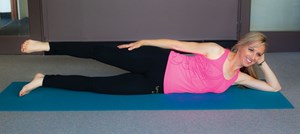
Instruction of Movement:
• Breathe out as you compress your top ribs and slide your top hand down your leg. Be careful that it’s your ribs that move toward your hips and not vice versa—we don’t want your pelvis to move.
• Keep your top leg very still and don’t move it up and down.
• Breathe in and return to start.
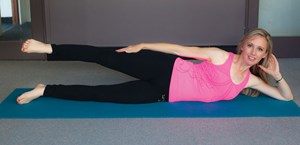
Criss-Cross
After performing lateral flexions, we progress to rotation. Here we target pelvic stability and trunk rotation together. This is a form of disassociation between the upper and lower body, which is necessary in riding.
Setup:
• Find your neutral pelvis, lying on your back with your legs off the ground and your knees bent at 90 degrees with your feet hip-joint-width apart.
• Keep your hands behind your head with your elbows wide and make sure that your head, neck and shoulder blades are off the ground.
• Add lateral breathing by breathing in through your nose and out through your mouth, making sure your shoulders stay relaxed. You should feel your ribs expand to the sides and back as well as the front, instead of just lifting your shoulders to make space for the expansion of your lungs.
• Switch off global muscles, that is, your legs and arms.
• Switch on your core.
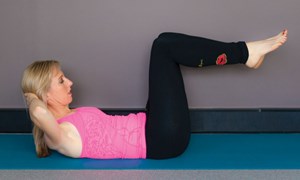
Instruction of Movement:
• Breathe out as you rotate your torso so that your right shoulder moves toward your left knee.
• Keep your chest angled toward your knee rather than your elbow, which should remain wide. Stretch your right leg out straight on a diagonal line.
• Breathe in and return to start.
• Repeat on the other side.
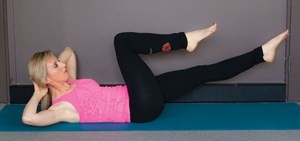
Rotation on a Fitball
Performing rotation exercises on a fitball is a great way to know whether you can really keep both sides of your waist equal while rotating your torso.
If you are cheating, then the fitball will show you immediately and push out from under you, just like
a horse!
Setup:
• Find your neutral spine and sit on the ball with equal weight in both of your seat bones.
• Press your palms together with your forefingers on your chin and thumbs on your chest so you can’t cheat by just moving your arms instead of your body.
• Add lateral breathing.
• Switch off your global muscles.
• Switch on your core.
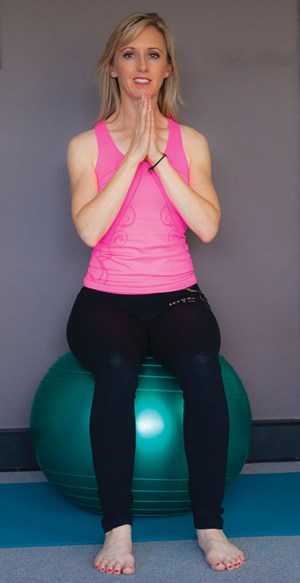
Instruction of Movement
• Breathe out and rotate from your centered position to the left, starting with your head and then working your way down your spine. Make sure your hips remain square to the front and the weight in your seat bones stays equal.
• Breathe in.
• Breathe out and return to center.
• Repeat to the right.
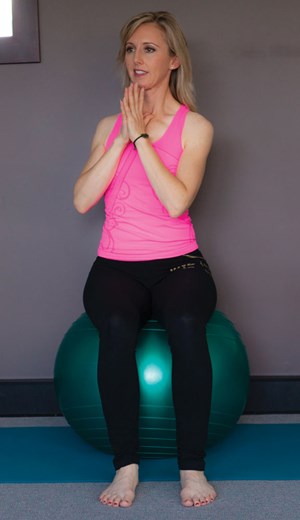
Rebecca Ashton is a qualified Pilates instructor, a British Horse Society-trained instructor and an Equestrian Australia-accredited dressage coach. She has competed through Intermediaire II, working with riders such as Anky van Grunsven and earning championship titles in the small tour. She lives in Australia and teaches clinics internationally (equestelite.com).




